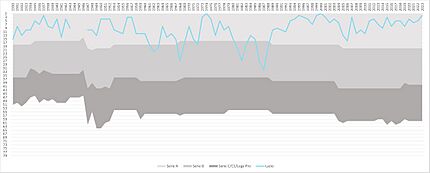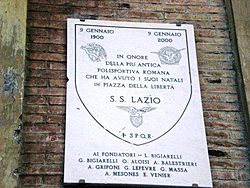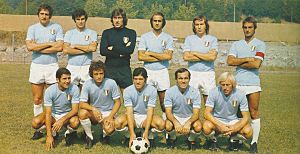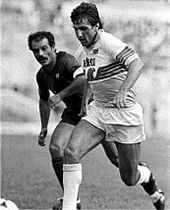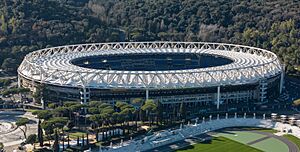SS Lazio facts for kids
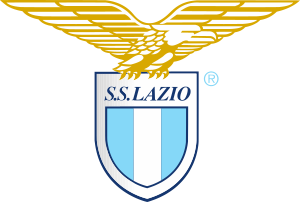 |
||||
| Full name | Società Sportiva Lazio S.p.A. | |||
|---|---|---|---|---|
| Nickname(s) | I Biancocelesti (The White and Sky Blues) I Biancazzurri (The White and Blues) Le Aquile (The Eagles) Gli Aquilotti (The Young Eagles) |
|||
| Founded | 9 January 1900, as Società Podistica Lazio | |||
| Ground | Stadio Olimpico | |||
| Capacity | 70,634 | |||
| Owner | Claudio Lotito (66.70%) | |||
| Chairman | Claudio Lotito | |||
| Head coach | Maurizio Sarri | |||
| League | Serie A | |||
| 2018–19 | Serie A, 8th of 20 | |||
|
||||
Società Sportiva Lazio (often called Lazio) is a professional sports club from Rome, Italy. It is most famous for its football team. The club started in 1900 and has spent most of its history playing in the top Italian football league, Serie A.
Lazio has won the Italian championship twice, in 1974 and 2000. They have also won the Coppa Italia seven times and the Supercoppa Italiana five times. On the international stage, they won the UEFA Cup Winners' Cup and the UEFA Super Cup once each. Lazio also won the Serie B title in 1969.
The team plays its home games at the Stadio Olimpico, which can hold 70,634 fans. They share this stadium with their city rivals, Roma.
Lazio's first big trophy was the Coppa Italia in 1958. In 1974, they won their first Serie A title. The 1990s were a very successful time for Lazio. They reached the UEFA Cup final in 1998. They then won the UEFA Cup Winners' Cup and UEFA Super Cup in 1999. They also won the Serie A title again in 2000.
After 2002, the club faced money problems. This led to their president, Sergio Cragnotti, leaving and many star players being sold. Despite these challenges, Lazio has won four more Coppa Italia titles since then: 2004, 2009, 2013, and 2019. Claudio Lotito became the club's president in 2004.
Lazio's traditional uniform colors are sky blue shirts, white shorts, and white socks. These colors represent Rome's ancient connection to Greece. Sometimes, they also use sky blue socks. Lazio has a strong and long-standing rivalry with Roma. Their matches are known as the Derby della Capitale (Derby of the Capital City).
Contents
Club History
Società Podistica Lazio was founded on January 9, 1900, in the Prati area of Rome. Until 1910, the club played as an amateur team. In 1912, they officially joined the Italian Football League. They reached the national championship final three times but lost each time. They lost to Pro Vercelli in 1913, Casale in 1914, and Genoa 1893 in 1923.
In 1927, Lazio was the only major club in Rome that did not merge with other city teams. This merger created Roma that same year. Lazio played in the first organized Serie A season in 1929. Led by famous Italian striker Silvio Piola, they finished second in 1937. This was their best result before World War II.
The 1950s saw Lazio finish in the middle or upper part of the league table. They won the Coppa Italia in 1958. In 1961, Lazio was relegated to Serie B for the first time. However, they returned to the top league two years later. After some years in the middle of the table, they were relegated again in 1970–71.
Back in Serie A in 1972–73, Lazio surprised everyone by challenging for the Scudetto (league title). They almost won it, losing on the last day to Milan and Juventus. The team included captain Giuseppe Wilson, midfielders Luciano Re Cecconi and Mario Frustalupi, striker Giorgio Chinaglia, and coach Tommaso Maestrelli. Lazio then won their first title in 1973–74.
Sadly, the deaths of Re Cecconi and coach Maestrelli, along with Chinaglia's departure, were big losses for Lazio. However, Bruno Giordano became a star, finishing as the league's top scorer in 1979.
In 1980, Lazio was forced down to Serie B because of a betting scandal. They stayed in the second division for three seasons. This was a very difficult time for the club. They returned to Serie A in 1983 and narrowly avoided relegation the next season. The 1984–85 season was very tough, as they finished last with only 15 points.
In 1986, Lazio faced another challenge. They had nine points taken away due to another betting scandal involving player Claudio Vinazzani. The club had a tough fight to avoid being relegated to Serie C. Led by coach Eugenio Fascetti, they managed to stay in Serie B after winning play-off games. This moment was a turning point for the club. Lazio returned to Serie A in 1988 and became a strong top-flight team under Gianmarco Calleri's financial management.
The arrival of Sergio Cragnotti as chairman in 1992 changed the club's future. He invested a lot in new players to make Lazio a title contender. An early big signing was English midfielder Paul Gascoigne in 1992. His transfer helped increase interest in Serie A in the United Kingdom. Cragnotti continued to break transfer records for star players. He signed Juan Sebastián Verón for £18 million, Christian Vieri for £19 million, and even briefly broke the world transfer record to sign Hernán Crespo for £35 million.
Lazio finished third in Serie A in 1995 and 1996, and fourth in 1997. In 1999, they lost the championship by just one point on the last day. But in 2000, with players like Siniša Mihajlović, Alessandro Nesta, Marcelo Salas, and Pavel Nedvěd, they won their second Scudetto. They also won the Coppa Italia, completing a double under manager Sven-Göran Eriksson.
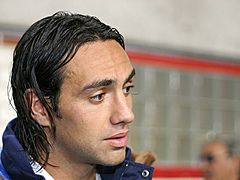
Lazio won the Coppa Italia again in 1998 and 2004. They also won the last ever UEFA Cup Winners' Cup in 1999. They reached the UEFA Cup final but lost to Internazionale. In addition, Lazio won the Supercoppa Italiana twice and beat Manchester United in 1999 to win the UEFA Super Cup. In 2000, Lazio became the first Italian football club to be listed on the Italian stock market.
As money became tight, Lazio's results declined. In 2002, a financial problem involving Cragnotti forced him to leave the club. Lazio was then managed by financial caretakers until 2004. This situation forced the club to sell their star players, including fan favorite captain Alessandro Nesta. In 2004, businessman Claudio Lotito bought most of the club.
In the 2006–07 season, Lazio finished third in the league, even after a points deduction. This earned them a spot in the UEFA Champions League qualifying rounds. They reached the group stage but finished fourth in their group. In the league, they struggled and finished 12th. In the 2008–09 season, Lazio won their fifth Coppa Italia, beating Sampdoria in the final.
Lazio started the 2009–10 season by winning the Supercoppa Italiana against Inter in Beijing. They won 2-1 with goals from Matuzalém and Tommaso Rocchi.
Lazio won the 2012–13 Coppa Italia 1-0 against their rivals Roma. The only goal was scored by Senad Lulić in the 71st minute.
Lazio won the 2018–19 Coppa Italia 2-0 against Atalanta, earning their seventh title. Sergej Milinkovic-Savic and Joaquin Correa scored the goals.
Lazio won the 2019 Supercoppa Italiana 3-1 against Juventus in Riyadh, Saudi Arabia. This was their fifth Supercoppa title. Luis Alberto, Senad Lulic, and Danilo Cataldi scored for Lazio.
In the 2024-25 UEFA Europa League group stage, Lazio finished first in the 36-club table with 19 points. They reached the quarter-finals after beating Viktoria Plzen 3-2 over two games in the round of 16.
Club Colors and Symbols
|
|
| First kit ever worn by the club |
Lazio's white and sky blue colors were inspired by the national emblem of Greece. This was chosen because Lazio is a club with many different sports. It recognized that the Ancient Olympic Games and European sports traditions are linked to Greece.
At first, Lazio wore a shirt with white and sky blue quarters, black shorts, and socks. After a short period of wearing a plain white shirt, Lazio returned to the colors they use today. Sometimes, Lazio has used striped sky blue and white shirts. But usually, it's a sky blue shirt with white trim, white shorts, and white socks. These colors led to their Italian nickname, Biancocelesti, meaning "The White and Sky Blues".
Lazio's traditional club symbol is the eagle. This was chosen by founding member Luigi Bigiarelli. The eagle was a symbol of the Roman legions and emperors, representing power and victory. It also connects the club to its home city of Rome. Because of the eagle, Lazio has two nicknames: le Aquile ("the Eagles") and gli Aquilotti ("the Young Eagles"). The current club badge shows a golden eagle above a white shield with a blue border. Inside the shield are the club's name and a smaller shield with the club's colors.
Kit Suppliers and Sponsors
| Period | Kit manufacturer | Main shirt sponsor | Alternate shirt sponsor | Secondary shirt sponsor | Shirt sponsor (back) | Shirt sponsor (sleeve) |
|---|---|---|---|---|---|---|
| 1946–1961 | Gradella Sport | None | None | None | None | |
| 1961–1962 | Lacoste | |||||
| 1962–1963 | Gradella Sport | |||||
| 1963–1964 | Lacoste | |||||
| 1964–1969 | Gradella Sport | |||||
| 1969–1970 | Tuttosport Umbro |
|||||
| 1970–1971 | Umbro | |||||
| 1971–1978 | Tuttosport NR (Ennerre) |
|||||
| 1978–1979 | NR (Ennerre) | |||||
| 1979–1980 | NR (Ennerre) Pouchain |
|||||
| 1980–1981 | Adidas NR (Ennerre) |
|||||
| 1981–1982 | Adidas | Tonini | ||||
| 1982–1984 | NR (Ennerre) | Sèleco | ||||
| 1984–1986 | Castor Eletttrodomestici | |||||
| 1986–1987 | Tuttosport | Cassa di Risparmio di Roma | ||||
| 1987–1989 | Kappa | |||||
| 1989–1991 | Umbro | |||||
| 1991–1992 | Banco di Santo Spirito | |||||
| 1992–1996 | Banca di Roma | |||||
| 1997–1998 | Cirio | |||||
| 1998–1999 | Puma | Del Monte Foods (in UEFA matches) | ||||
| 1999–2000 | Stream TV (in cup matches) / Del Monte Foods (in UEFA matches) | |||||
| 2000–2002 | Siemens Mobile | None | ||||
| 2002–2003 | Cotonella (in cup matches) / Compex (in cup matches) | |||||
| 2003–2004 | Parmacotto | Indesit (in cup & UEFA matches) | ||||
| 2004–2005 | Errebian (in supercup matches) | |||||
| 2005–2007 | INA Assitalia | None | ||||
| 2007–2008 | None | So.Spe. (Matchday 2, 7, 8, 10-11, 15-19, 21-24, 26 & 28-30 & cup matches) / Edileuropa (25, 27, 29-31, & 34-38) | ||||
| 2008–2009 | Pro Evolution Soccer 2009 (Matchday 15) / Cucciolone (16 & 18) / Groupama (31) | |||||
| 2009–2010 | Edileuropa | Clinica Paideia (Matchday 4 & 12) / Regione Lazio (in supercup matches) | ||||
| 2010–2011 | None | Clinica Paideia (Matchday 12 & 37) | ||||
| 2011–2012 | Clinica Paideia (Matchday 7 & 11) | |||||
| 2012–2013 | Macron | Clinica Paideia (Matchday 17-18) | ||||
| 2013–2014 | Lazio Style Channel (Matchday 10, 19 & 24) / Clinica Paideia (23) | |||||
| 2014–2015 | Clinica Paideia (Matchday 2, 8, 12 & 19) / Associazione italiana contro le leucemie-linfomi e mieloma (13) | |||||
| 2015–2016 | Extraordinary Jubilee of Mercy (Matchday 15) / Clinica Paideia (30, 34 & 36) | |||||
| 2016–2017 | Sèleco | Clinica Paideia (Matchday 15) / Libera (30) | ||||
| 2017–2018 | None | Clinica Paideia (Matchday 14 & 19) | Sèleco Easy Life | |||
| 2018–2019 | Marathonbet | None | Sèleco / Igea Banca (in Coppa Italia Final) | Clinica Paideia (Matchday 21 & 26) | ||
| 2019–2020 | None | Regione Lazio (in supercup matches) | None | Clinica Paideia (Matchday 2 & 15) / Frecciarossa (Matchday 27-38) | ||
| 2020–2021 | World Food Programme (Matchday 13) / Contrader (31) / Clinica Paideia (37) | Contrader | Frecciarossa | |||
| 2021–2022 | Binance | None | Clinica Paideia (Matchday 6 & 34) | |||
| 2022–2023 | Mizuno | Clinica Paideia (Matchday 27) | AIRFire (Matchday 19-38) | |||
| 2023–2024 | None | Clinica Paideia (Matchday 16, 30 & 33) / Regione Lazio (in supercup matches) | None | AeroItalia | ||
| 2024–2025 | Casa di Cura Villa Mafalda (Matchday 36) | AeroItalia | None | |||
Home Stadium
The Stadio Olimpico is Rome's main stadium. It is located in the Foro Italico area. It is the home stadium for the Italy national football team and both Lazio and Roma. The stadium first opened in 1937. After its most recent updates in 2008, it can hold 70,634 people.
The Stadio Olimpico has hosted many important events. These include the 1960 Summer Olympics, the 1987 World Athletics Championships, the 1980 European Championship final, and the 1990 World Cup. It also hosted the Champions League Final in 1996 and 2009.
Near the Stadio Olimpico is the Stadio dei Marmi, or "marble stadium." It was built in 1932 and has 60 white marble statues. These statues were gifts from Italian cities to honor 60 athletes.
During the 1989–90 season, Lazio and Roma played their games at the Stadio Flaminio in Rome. This was because the Stadio Olimpico was being renovated.
In June 2018, Lazio President Claudio Lotito said that Lazio should also be allowed to build a new stadium, just like Roma. He hoped Lazio's stadium would be built first. In June 2019, Lotito was expected to show designs for a possible future stadium for Lazio, called the Stadio delle Aquile. However, this did not happen. In July 2021, Lotito changed his mind. He started thinking about moving the club's home to a renovated Stadio Flaminio.
In October 2022, Lotito shared an update on his Stadio Flaminio plan. He said he really hoped Lazio would play there again. He felt it would connect the club to its history. In November 2022, Lotito talked more about his plans for the Stadio Flaminio. He wanted to increase the stadium's capacity from about 18,000 to 45,000 seats. He said it was a problem for Lazio not to have its own stadium.
In September 2024, Lazio took real steps to own and renovate the Stadio Flaminio. The club planned to work with a company called “Legend.” This company builds and manages sports venues. They would handle ticketing, merchandise, sales, and finding a naming sponsor. Emirates was reportedly interested in being the sponsor. The total cost was estimated to be between €250 and €300 million.
In December 2024, Lotito met with Rome's Mayor Roberto Gualtieri to present his project for the new Stadio Flaminio. He imagined a modern stadium with 40,000 to 50,000 seats and a roof that could open and close. He also planned to redevelop the area around the Flaminio district. He said the project was well-received, but getting all the necessary approvals could take another three years.
However, shortly after, another group called "Roma Nuoto" got approval for their plans for the abandoned stadium. They wanted to create a multi-sport facility with a swimming pool, padel courts, and a hockey rink. This meant they were competing with Lazio for the Stadio Flaminio.
In March 2025, Lotito officially submitted his proposal for the Stadio Flaminio to become Lazio's new home. Lazio hopes to finish the paperwork by early 2026 and complete the renovation work by summer 2029. The renovated stadium would have 50,750 seats. The cost for renovating the stadium and the surrounding area is estimated at €438 million.
In April 2025, the "Roma Nuoto" project for the Stadio Flaminio was rejected by the Rome Municipality Council. They decided it was not suitable for a large stadium hosting major events. The rejected project would have reduced the stadium's capacity from 42,000 to just 7,500 seats.
Supporters and Rivalries
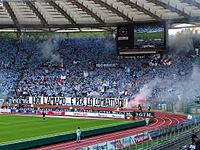
Lazio is the sixth-most supported football club in Italy and the second most popular in Rome. About 2% of Italian football fans support the club. Historically, most Lazio supporters in Rome come from the northern part of the city. This includes wealthy areas like Parioli, Prati, Flaminio, Cassia, and Monte Mario.
Irriducibili Lazio was the club's biggest fan group for over 30 years, starting in 1987. They often create large displays during the Derby della Capitale (Rome Derby). This is the match between Lazio and their main rivals, Roma. It is one of the most intense football rivalries in the world. Sadly, a Lazio fan named Vincenzo Paparelli was killed during a derby game in the 1979–80 season. He was hit by a flare thrown by a Roma fan.
The Irriducibili group disbanded on February 27, 2020. They said there was "too much blood, too many banning orders, too many arrests." Lazio's main fan group is now called Ultras Lazio. Lazio also has strong rivalries with Napoli and Livorno. They also have rivalries with Pescara and Atalanta. The club also competes strongly with Fiorentina, Juventus, and Milan.
On the other hand, Lazio's fans have friendly relationships with supporters of Internazionale, Triestina, and Hellas Verona. Internationally, Lazio fans have a long-standing friendship with supporters of the Bulgarian club Levski Sofia. Because of this, Lazio was invited to play in a special football match celebrating Levski Sofia's 100th birthday.
Club Achievements
Italian Trophies
- Serie A
- Winners (2): 1973–74, 1999–2000
- Runners-up (7): 1912–13, 1913–14, 1922–23, 1936–37, 1994–95, 1998–99, 2022–23
- Serie B
- Winners (1): 1968–69
- Coppa Italia
- Winners (7): 1958, 1997–98, 1999–2000, 2003–04, 2008–09, 2012–13, 2018–19
- Runners-up (3): 1960–61, 2014–15, 2016–17
- Supercoppa Italiana
- Winners (5): 1998, 2000, 2009, 2017, 2019
- Runners-up (3): 2004, 2013, 2015
European Trophies
- UEFA Cup Winners' Cup
- Winners (1): 1998–99
- UEFA Super Cup
- Winners (1): 1999
Current Players
|
|
Players on Loan
|
|
Other Players Under Contract
|
|
Retired Jersey Number
12 – Since the 2003–04 season, the Curva Nord (North Stand) of Stadio Olimpico is considered the 12th player on the field. This is a way to show appreciation for the fans.
Club Officials and Staff
Famous Managers
The following managers have all won at least one trophy while leading Lazio:
| Name | Time at Club | Trophies Won |
|---|---|---|
| 1958–1960 | Coppa Italia | |
| 1968–1971 | Serie B | |
| 1971–1976 | Serie A | |
| 1997–2001 | 2 Coppa Italia, 2 Supercoppa Italiana, Serie A, UEFA Cup Winners' Cup, UEFA Super Cup | |
| 2002–2004 | Coppa Italia | |
| 2005–2009 | ||
| 2009–2010 | Supercoppa Italiana | |
| 2012–2014 | Coppa Italia | |
| 2016–2021 | 2 Supercoppa Italiana, Coppa Italia |
Club Records
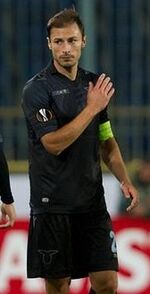
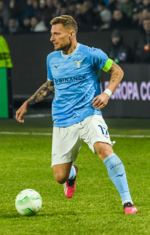
Ștefan Radu holds the record for the most official appearances for Lazio, with 416 games played. The goalkeeper with the most appearances is Luca Marchegiani, who played 339 times. The record for most league appearances is held by Aldo Puccinelli with 339 games.
The all-time leading goalscorer for Lazio is Ciro Immobile, with 206 goals. He is followed by Silvio Piola with 159 goals. Piola is also the highest goalscorer in Serie A history, with 274 goals. Immobile is also Lazio's top goalscorer in European competitions, with 26 goals.
Lazio's highest home attendance was about 80,000 fans. This was for a Serie A match against Foggia on May 12, 1974. That match won Lazio their first Scudetto. This is also the record for the Stadio Olimpico, including games played by Roma and the Italy national football team.
Lazio as a Business
In 1998, when Sergio Cragnotti was chairman, Società Sportiva Lazio S.p.A. became a company whose shares could be bought and sold on the stock market. Lazio was the first Italian club to do this. However, Cragnotti left in 2001 due to financial problems at the club.
Claudio Lotito, the current chairman, bought the club from Cragnotti in 2004. At first, he owned about 27% of the shares. He later bought more shares from a banking group. As of 2018, Claudio Lotito owns over two-thirds of Lazio's shares. Lazio is one of only three Italian clubs listed on the Borsa Italiana (Italian stock exchange), the others being Juventus and Roma.
Lazio is known for being one of the few clubs that can support itself financially without needing a lot of money from its owners. It also often makes a profit each season. Unlike some other big Italian clubs, Lazio has met the financial rules set by UEFA. Lotito even received an award for Lazio's good financial health.
In 2017, the club renewed its sponsorship deal with kit maker Macron. This deal was worth €16 million per season, plus extra money based on how well they did in the league and European competitions.
In February 2022, Lazio announced they were no longer working with Macron after 10 years. Mizuno became the team's new sportswear provider. Lazio would receive €20 million over the next five years from this new agreement with the Japanese company.
In March 2022, Lazio shared its financial reports for June to December 2021. These reports showed that their income decreased, but their profit increased.
In March 2025, an Italian newspaper reported that Lazio might soon have its own TV show on Netflix. This show would be about the club's history, from its founding in 1900 to today. It would cover Lazio's wins and its dedicated fans. Famous players like Giuseppe Signori, Miroslav Klose, and Paolo Di Canio might appear in the series.
In March 2025, Lazio released its financial reports for June to December 2024. They showed €87.5 million in total income. The club also reduced its costs from €97.2 million the year before to just under €87 million.
| Year | Turnover | Result | Total Assets | Net Assets |
|---|---|---|---|---|
| 2005–06 | €87,945,533 | €16,790,826 | €150,061,486 | (€25,406,939) |
| 2006–07 | ||||
| 2007–08 | ||||
| 2008–09 | ||||
| 2009–10 | ||||
| 2010–11 | ||||
| 2011–12 | ||||
| 2012–13 | ||||
| 2013–14 | ||||
| 2014–15 | ||||
| 2015–16 | ||||
| 2016–17 |
See also
 In Spanish: Società Sportiva Lazio para niños
In Spanish: Società Sportiva Lazio para niños
- Football in Italy
- Lazio (futsal)
- Lazio Women


